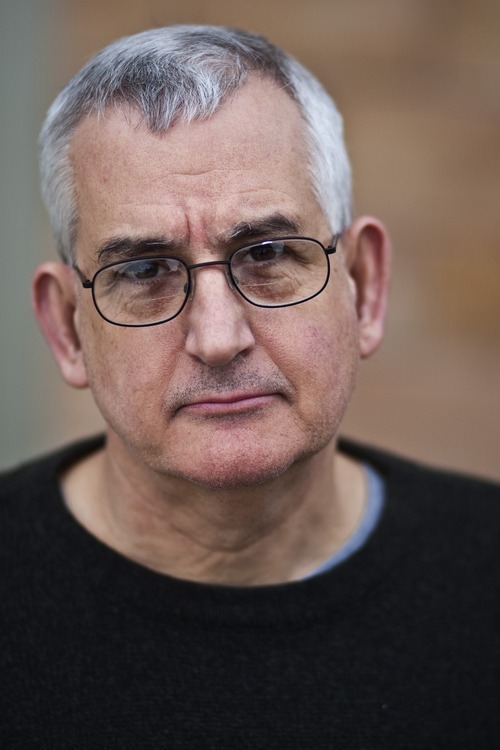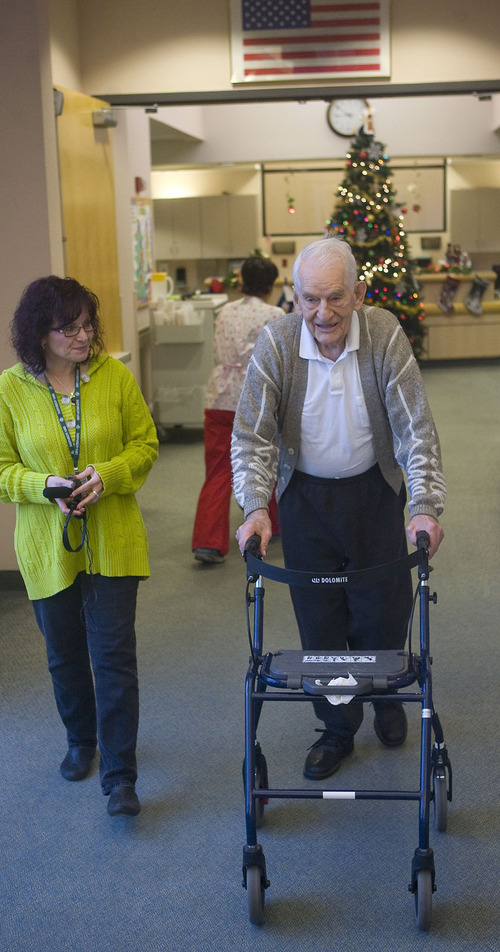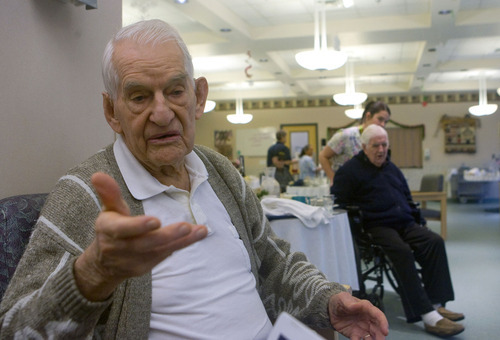This is an archived article that was published on sltrib.com in 2010, and information in the article may be outdated. It is provided only for personal research purposes and may not be reprinted.
Gilbert Gooch is lost in the Philippines. The heat, the humidity, the enormous insects — nearly 70 years have passed since he returned from World War II, but it's all right there.
The lonely days. The frightening days. The funny days.
Then a pretty brunette walks by in tie-dyed hospital scrubs. And with that, Gooch is back in the dining room at the Utah State Veterans Nursing Home.
"Hello, doll," he says with a wink, a raised eyebrow and a smile.
The orderly smiles back, blushes a bit and moves on.
"I love 'em," Gooch says. "You know, you don't quit loving girls at 93."
There's a lot of life behind him. But Gooch is pretty sure there's a lot ahead, too. And he could be right.
When Gooch was born, the life expectancy for an American man was a little more than 50 years. Today it's a little less than 80. The U.S. Census Bureau estimates that more than 70,000 Americans are 100 years old or older — and the number of centenarians is expected to triple in the next 15 years.
Americans are living longer. And that means the memories, the consequences and the costs of the wars they've fought are living longer, too.
—
Looking after veterans • Sarah Howell knew she wasn't just signing up to join the Army — she was signing up for war.
"My mom pounded that into my head," said the 18-year-old soldier, one of the newest recruits in the Utah National Guard. "She said, 'You will be deployed. It's not a question of if, it's just a matter of when."
But the Boise, Idaho, native, who is attending Utah State University, was determined. She wanted to serve her country, see the world and earn some money for school.
Beyond that, Howell said, she hasn't thought much about what the nation will owe her for her service. And Utah Department of Veterans Affairs Director Terry Schow says she shouldn't have to.
"When someone raises his or her hand and makes the decision to join the military, they usually do that without any higher expectations," Schow said. "In return, our country says to them, 'We will care for you' — and that's exactly what we should do."
Schow is among many veterans advocates who contend that the nation still hasn't done enough, though he acknowledges that today's benefits are better than ever before. During the course of American history, veterans entitlements have grown from the simple pensions given to soldiers after the Revolutionary War to a menu of educational, occupational, economic and medical benefits.
Today, nearly every veteran can tap into subsidized home loans, tuition allowances and vocational training. Those recently home from the nation's ongoing wars are eligible for free medical care for a period of several years. Those who can connect a disability to their service are eligible for compensation and free health care for life.
In the next 10 years alone, the Congressional Budget Office predicts, the United States will spend nearly $1.3 trillion trying to keep up with its responsibilities to its veterans.
That's more than the nation has spent in nine years of war in Iraq and Afghanistan.
—
Astronomical expense • It wasn't supposed to be this expensive.
In late 2002, Larry Lindsey, a senior economic adviser to then-President George W. Bush, predicted the impending war in Iraq could cost up to $200 billion. Defense Secretary Donald Rumsfeld bristled at that number, calling such estimates "baloney." Rumsfeld's team suggested the war would cost around $50 billion — and might be paid for by postwar oil sales.
Lindsey was asked to step down. A few months later, the Iraq war began.
The cost of that war so far? Almost $750 billion, according to the National Priorities Project.
But Chris Hellman, a military-policy analyst for the Massachusetts-based nonprofit, said that's only the direct costs, "appropriated by Congress, earmarked for military operations, for nation-building and economic recovery and those types of things."
What Hellman's figure — which ticks ever upward at http://www.costofwar.com — doesn't include are the consequential costs: medical care for the wounded, benefits to the families of the fallen, and insurance settlements for civilian contractors, among other obligations that U.S. taxpayers will be expected to pay in decades to come.
When Nobel Prize-winning economist Joseph E. Stiglitz sat down with Harvard public-finance expert Linda Bilmes to try to predict the long-term costs of the war in Iraq, they came up with a number that became the title of their book: The Three Trillion Dollar War.
Two years after publication, however, the authors think they may have vastly underestimated.
"We could have called it the $4-to-$6 trillion war," Bilmes said.
But Bilmes said the goal wasn't to put a precise price tag on the conflict. The costs can be hard to comprehend, no matter what digit sits before the word "trillion," she said.
The point, she said, "is that this thing is big — and it's not going away."
The authors say they've deliberately used conservative figures in their calculations. For instance: They estimated that veterans of the current war in Iraq would seek disability compensation from the federal Veterans Benefits Administration at the same rate as those who served during the 1991 war in that country — even though the earlier fight lasted less than two months, with a ground campaign of just 100 hours.
But even a "small war" can have long-term consequences: Veterans from the first war in Iraq have filed 350,000 disability claims. Their care and compensation cost the U.S. roughly $4.3 billion a year, according to the advocacy group Veterans for Common Sense.
That's likely to be just a fraction of what it will cost to care for the most recent generation of war veterans. Nearly 400,000 of the 2.2 million military members who have served in Iraq and Afghanistan are already being treated by the Veterans Health Administration, according to the Congressional Budget Office. Not including disability compensation or any other benefits, the annual price of their medical care has swelled from $260 million in 2005 to nearly $2 billion in 2010.
And the costs keep rising.
—
Longevity increases • Since 2001, the price of health care has risen by an average of 4 percent each year, nearly twice the average increase of all other goods and services, according to the U.S. Bureau of Labor Statistics. When the bureau's medical index, which tracks the cost of care for average Americans, inexplicably fell (by a mere one-tenth of 1 percent) in July, it was the first dip in 35 years of monthly tracking.
"When you have a trend like that, a trend that is very long, you can be more confident that it's going to continue," said Washington, D.C., economist Steve Reed.
As the largest health care administrator in the U.S., the Department of Veterans Affairs is slightly insulated, but by no means immune, from myriad forces that drive up the price of medicine.
One factor: increased longevity.
The waiting list for one of the 80 beds at the Utah State Veterans Nursing Home has nearly 90 names on it. Many of those who call to inquire about openings don't even bother to add their loved ones to the list, said the home's interim director, Todd Hansen. Most of the residents — including 18 who are more than 90 years old — aren't likely to be going anywhere anytime soon, he said.
"Long-term care facilities are better and health care is better, and so what we see, not unexpectedly, is that people are living longer," Hansen said.
"In World War II, if you were shot up badly, you're not in a nursing home today because you passed on," he said. "But in Vietnam, we saved so many people who were badly injured that are still alive today. That's not cheap. It's incredibly expensive. But we enable them to live long and, hopefully, rich lives. And do we owe them that? Yeah, I think we probably do."
—
Mental health a priority • With a budget that has more than doubled in the past 10 years — from a little less than $50 billion in 2000 to about $125 billion today — the VA is devoting record resources to researching and treating war-related health problems.
In the past, the federal government has failed to address its veterans' needs "the way that might have been and the way that should have been," VA Secretary Eric Shinseki said during a visit to Salt Lake City earlier this year.
Now, he said, "We're trying to do something about that."
Mental health, for example: For most of the 20th century, the government simply ignored the psychological consequences of combat. Today, with studies indicating that about a third of veterans of the wars in Iraq and Afghanistan suffer from post-traumatic stress disorder or another mental illness, Shinseki has made mental health a top priority for his department. But keeping up that level of commitment will be a long — and expensive — endeavor.
Gita Rakhsha's youngest patients are just months out of the military. Her oldest is a World War II veteran who is 92.
"He still sleeps with a gun under his pillow every night," said Rakhsha, a staff psychologist at the George E. Wahlen VA Medical Center in Salt Lake City.
Older veterans often come into the VA for the first time after a significant change in their lives.
"Sometimes, it's retirement. Sometimes, it's the loss of their spouse," she said. "It's almost as though they've been holding things together for so long and the stressors in their lives finally overtax the internal resources they have."
Rakhsha said she's certain the U.S. will be addressing the psychological costs of the current wars for many decades to come. But she's hopeful that the recent push to provide early care will help prevent a wave of "late onset" cases such as those being seen among veterans of World War II, Korea and Vietnam.
Indeed, a 2008 study by RAND Corp. suggests that early intervention could save billions of dollars throughout the lifetimes of veterans from the current wars.
But those savings could be offset — and even eclipsed — by new VA policies aimed at helping veterans access compensation with fewer bureaucratic obstacles.
Now, nearly any veteran who has served in a war zone can receive compensation for PTSD without proving they were exposed to a "triggering event" such as a bombing or firefight.
More than 400,000 veterans from all conflict periods are already being compensated for PTSD. That number is expected to increase substantially this year, triggered largely by the policy change.
Once benefits are granted, the checks usually keep coming for the rest of a veteran's life. Officials say it's extremely rare for a veteran's compensation to be reduced — even though, especially in the case of PTSD, many veterans ultimately learn how to manage their symptoms and no longer need care.
—
Payments go on for decades • The armistice that ended World War I was signed on Nov. 11, 1918. It took 51 more years for benefit payments — including compensation, medical care and other entitlements — to peak, according to Bilmes, The Three Trillion Dollar War co-author.
It took 52 years after World War II. And today, 57 years after the Korean armistice, the U.S. appears to have reached the peak of payments to veterans of that war.
Projecting those time frames forward, payments to veterans of the Vietnam War could continue growing for another two decades. Payments to veterans of the first war in Iraq may continue to increase through the 2050s. And the peak for the current wars in Iraq and Afghanistan may not come until 2070 — with the final payments being made well into the 22nd century.
Of course, that's assuming that the nation keeps the promises it has made to its veterans. And John Reed isn't confident that will happen.
"A lot of people think that the United States' economy is in a process of near-permanent slowdown," said Reed, who lectures on American military history at the University of Utah. "At some point, the cost of taking care of all these veterans is going to become a point of contention, a point of debate."
Reed, who served in Iraq during the troop surge of 2007 and 2008, believes that many people will come to feel absolved of responsibility to war veterans because those who serve today are volunteers, not conscripts drawn in by a draft, and because the reasons for the wars may seem unclear.
"Even today, people are having trouble making sense of these wars," he said.
—
One last battle • The nation's oldest war veteran — 109 years old and counting — is Frank Buckles, a West Virginia farmer who lied about his age to enlist in the Army at 16 and is the last surviving soldier from World War I.
Until a few years ago, Buckles still took his tractor out for an occasional spin on the gently rolling acres of his home at Gap View Farm, near Shenandoah Junction.
Now Buckles is fighting one final battle: pursuing a national memorial for the soldiers of The Great War on the National Mall in Washington, D.C. But 92 years after the end of the war in which he fought, few Americans can explain why their country joined the war in the first place.
Edwin Fountain, a member of the board of directors for the World War I Memorial Foundation, on which Buckles serves as honorary chairman, said that war has been pushed aside by all the other wars of a bloody "American century."
And yet, he says, "The effects of World War I are still being felt — and fought — today. We are in Iraq because of decisions and boundaries that were drawn because of World War I."
Another effect: American taxpayers remain obligated to Buckles.
As a successful farmer, Buckles has never needed — or asked — for much from the nation he served. But when he dies, he'll be eligible to be buried in a federal veterans cemetery under a headstone provided by the U.S. Department of Veterans Affairs.
A team of soldiers will present his family with a crisply folded flag. A bugler will sound taps. And with that, the last doughboy will be laid to rest.
Still, the nation's direct obligations will not be complete. U.S. taxpayers are still providing benefits to about 10,000 surviving spouses and children of those who served in "the war to end all wars."
One hundred years later, that war lingers on.
And 100 years from now?
Those who remain
About 16 million living veterans have served the U.S. during a past war.
Source • National Center for Veterans Analysis and Statistics

















